LUREC-2023
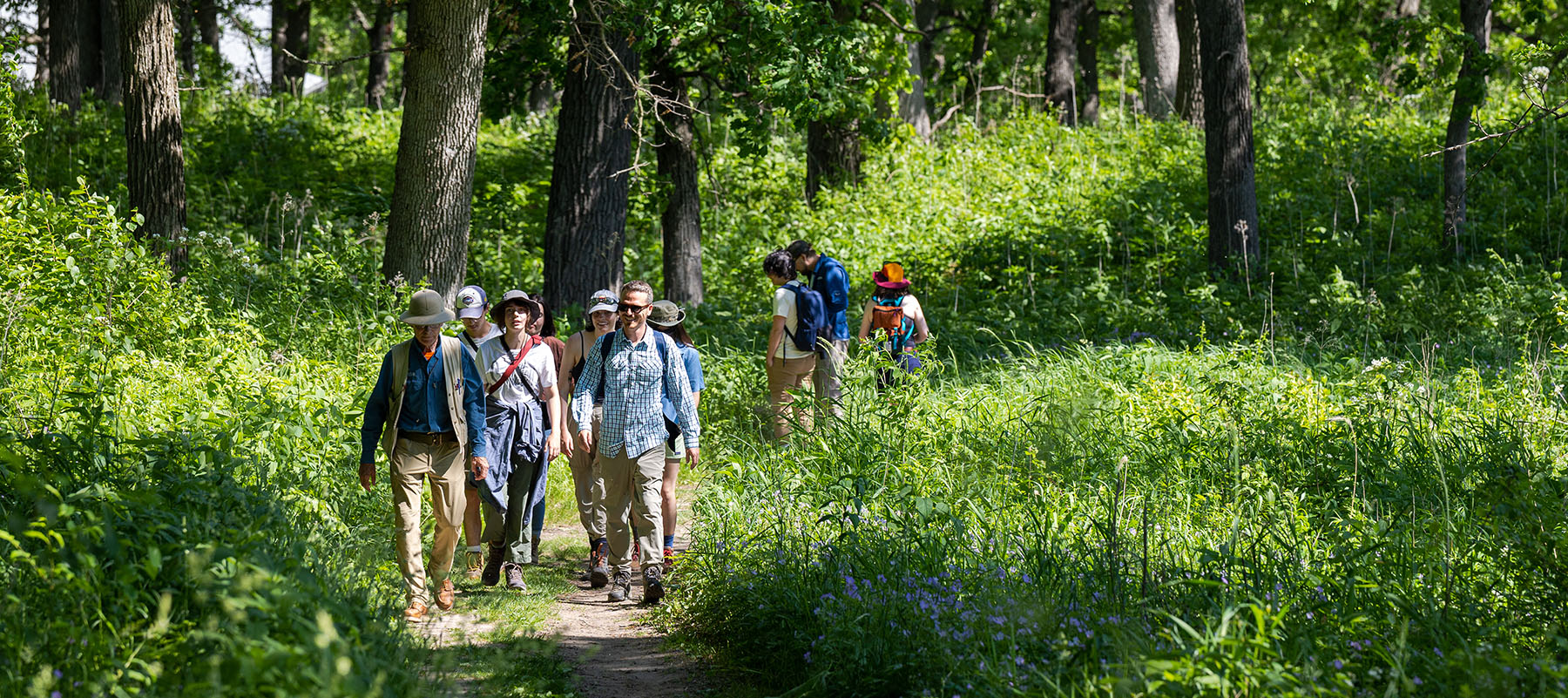
Students Explore Nature's Classroom
This summer, Loyola students studied ecological principles, explored Northern Illinois’ diverse natural areas, and encountered local wildlife during the School of Environmental Sustainability’s intensive three-week session at the Loyola University Retreat and Ecology Campus (LUREC). Students immersed themselves in the ecosystems they were studying and came away with a renewed appreciation of the natural world. They also made new friends and had fun learning through hands-on experience.
LUREC is 50 miles northwest of the University’s Lake Shore Campus in McHenry County, Illinois. The campus includes hotel-style and dormitory accommodations, a dining hall, classrooms, lab facilities, and 100 acres of green space—making it an ideal location to study ecology and environmental sustainability.
SES offered two courses during this year’s LUREC summer session: principles of ecology (lecture and lab) and a new class on herpetology (the study of reptiles and amphibians). Students signed up for one of the two classes and lived on campus at LUREC during the session. Both courses included classroom instruction, lab activities, field trips, and hands-on outdoor experiences. Mark Mackey, SJ, MS, taught herpetology, and he had several goals for the course.
“I hoped students would be able to expand their ecological worldview to include the fascinating world (and requirements) of reptiles and amphibians,” he said. “By the end of the class, students learned the names, natural history, and identifying characteristics of the 100-plus species of reptiles and amphibians found in Illinois.”
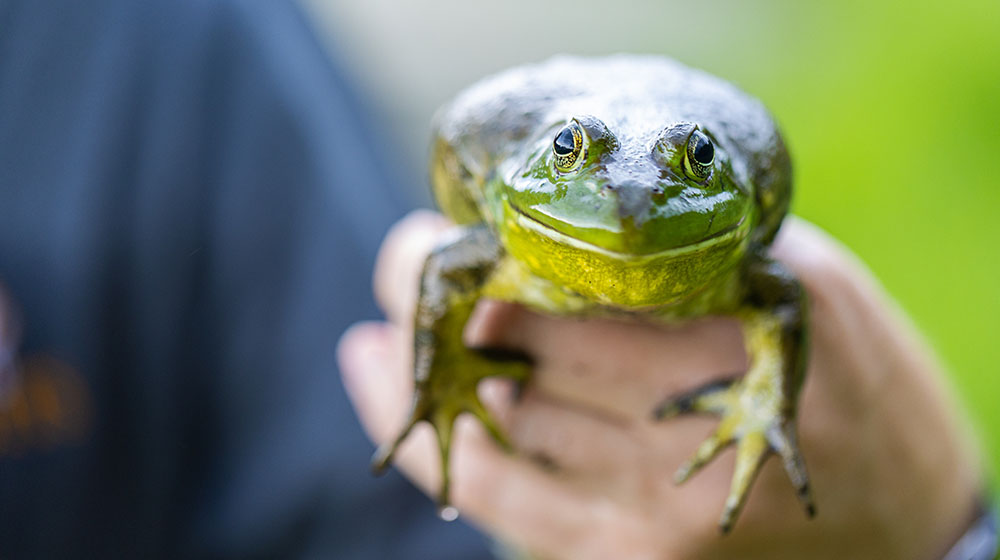
Herpetology students learned how to handle animals such as this American bullfrog, which they found at LUREC.
Students interacted with 23 of reptiles and amphibians on the LUREC campus and in local natural areas. They learned to handle animals like green frogs, American toads, painted turtles, and milk snakes. Mackey said he was excited that they could catch and examine six milk snakes at LUREC.
“Milk snakes are rather secretive and can be quite hard to find, so to find this many individuals just a couple hundred yards from our indoor classroom was quite special,” he said.
Asha Egmont, a senior majoring in environmental studies and jazz studies, said she particularly enjoyed using technology to study turtles. She and her classmates used large hoop traps to catch turtles living in the pond at LUREC. They collected data such as species, size, and location before releasing the animals back into the pond. In some cases, the students outfitted turtles with a radio tracker that they later removed.
“We stick it on the back of their shell, and then they swim around. Then we walk around with an antenna and listen to some beeps, and when it gets louder, you know you’re getting closer. It’s like a big game of hot and cold,” Asha said.
The exercise helped students understand the turtles’ movements and gave them experience with wildlife radio telemetry—a tool scientists use to study animal behavior and population dynamics.
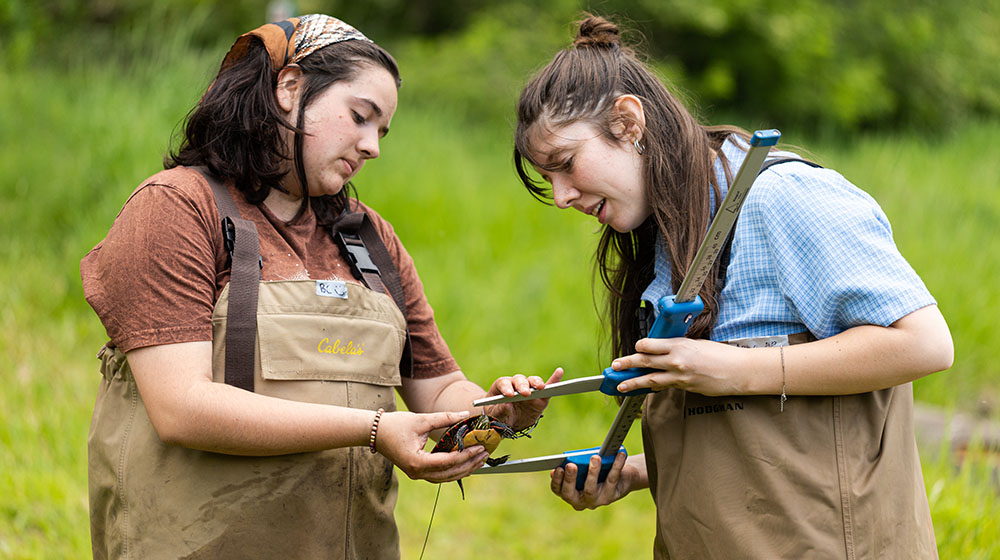
Students took measurements of the reptiles and amphibians they found at LUREC.
In addition to learning to identify local reptiles and amphibians, the herpetology students completed research projects and got practice with standard ecological research methods. They expanded their understanding of how herps interact with their environment and discovered how studying the animals can offer insights into broader ecological questions.
For many of Mackey’s students, being outside and interacting with the animals were highlights of the LUREC experience.
“Catching a snake is a cool feeling,” said Alex Risdal, a sophomore double majoring in environmental science and music. “I never thought I’d be able to reach into the bushes and grab a snake, and now I’m going around looking for them,” she said.
The outdoor activities were also a draw for students in the principles of ecology course, including Keylon Hampton, a senior majoring in environmental studies.
“I wanted to have an immersive experience outside. Having that immersive experience and being able to take what we learn in the classroom and being able to see it physically,” he said.
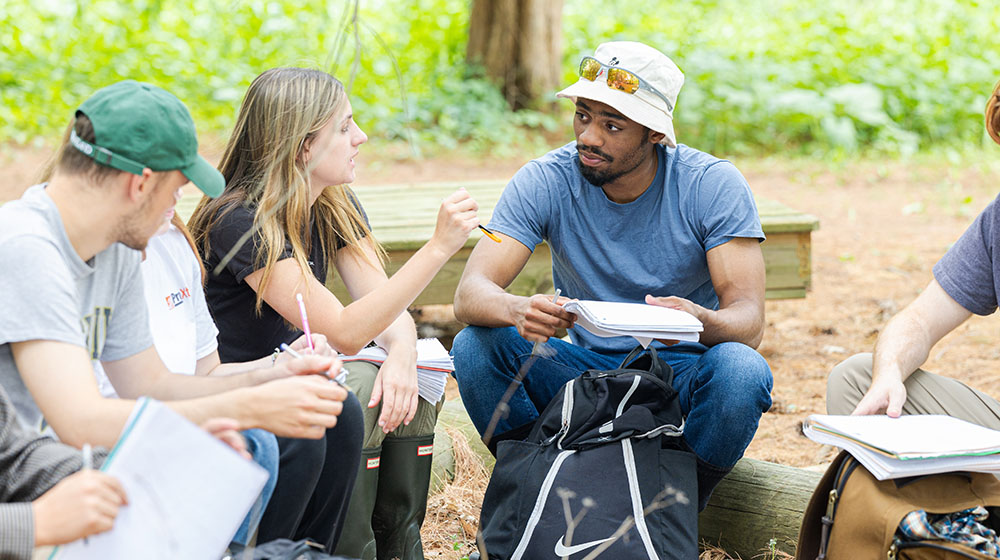
Frances Clinite and Keylon Hampton enjoyed the opportunity to learn outdoors in nature during the LUREC summer session.
Associate Professor Ray Dybzinski, PhD, taught the principles of ecology course, which covered roughly a semester’s worth of material in a shortened time frame.
“I think the fact that it’s all so concentrated is a challenge, but it’s also an opportunity because we’re so immersed in this for three weeks,” said Dybzinski. “And I think the community building and the social aspects of this kind of learning are phenomenal.”
Dybzinski said teaching ecology at LUREC has some distinct advantages compared with a typical classroom setting. He noted that the 100-acre campus features habitats including grasslands, wetlands, oak savannas, agricultural fields, a pond, and a creek.
“There’s a lot of habitats crushed into one little space. For teaching ecology that’s very useful because in a short walk we can traverse very different habitats and look at how ecological principles play out differently in those different habitats,” he said.
During their time at LUREC, Dybzinski’s students took classroom learning into the field, and they brought samples collected outdoors into the lab for closer examination. Madi Biesinger is a senior in environmental science from San Antonio, Texas. She said she enjoyed collecting water from a pond on campus and looking at tiny aquatic organisms under a microscope.
“It was so cool to go out and gather my samples and then look at what I was able to gather and see things and identify them,” she said.
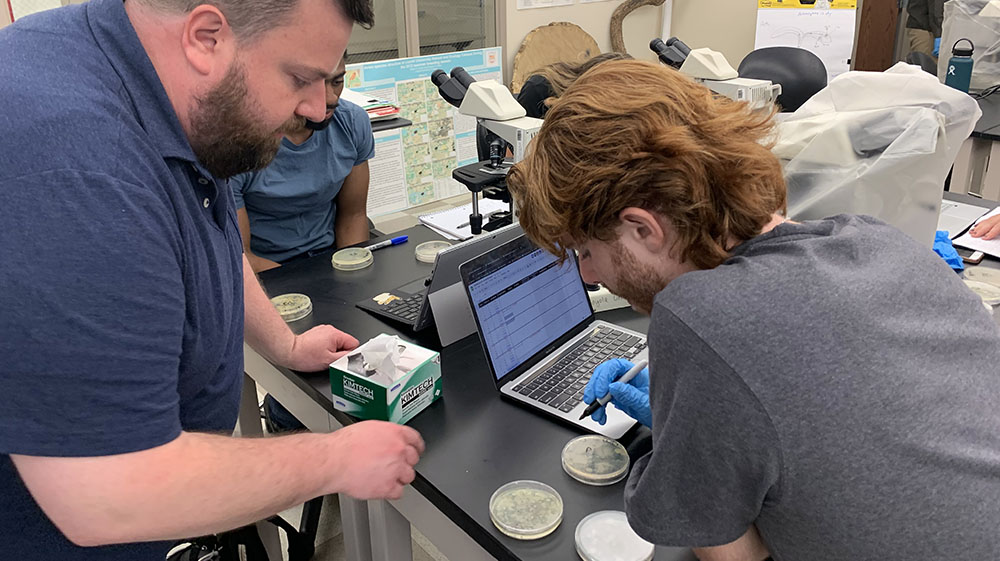
Greg Palmer, PhD, led lab activities focused on examining the diversity and abundance of microbes living in soil.
In another activity, microbiologist Greg Palmer, PhD, joined Dybzinski to lead an activity exploring the diversity of microscopic life found in soil. During the first week of the class, students collected soil samples at various locations on the LUREC campus. Under Palmer’s guidance, they mixed the soil with sterile water, created different dilutions, and put samples into Petri dishes containing agar. Palmer returned in the third week of class to help students examine the microbial colonies that grew in the Petri dishes. They found that the soil contained a tremendous quantity and variety of microbes.
“So that’s one thing I want the students to understand,” said Palmer. “There’s incredible diversity in every little gram of soil you walk on all the time. So when we think about the diversity of life on the planet, we need to not just think about tropical rain forests and coral reefs. The soil that we’re walking on every day has millions and millions of microbes.”
The microbes in soil play vital roles in decomposing organic matter and making nutrients available to plants. They also produce compounds that can be useful to people. Most of the antibiotics in use today come from bacteria found in soil.
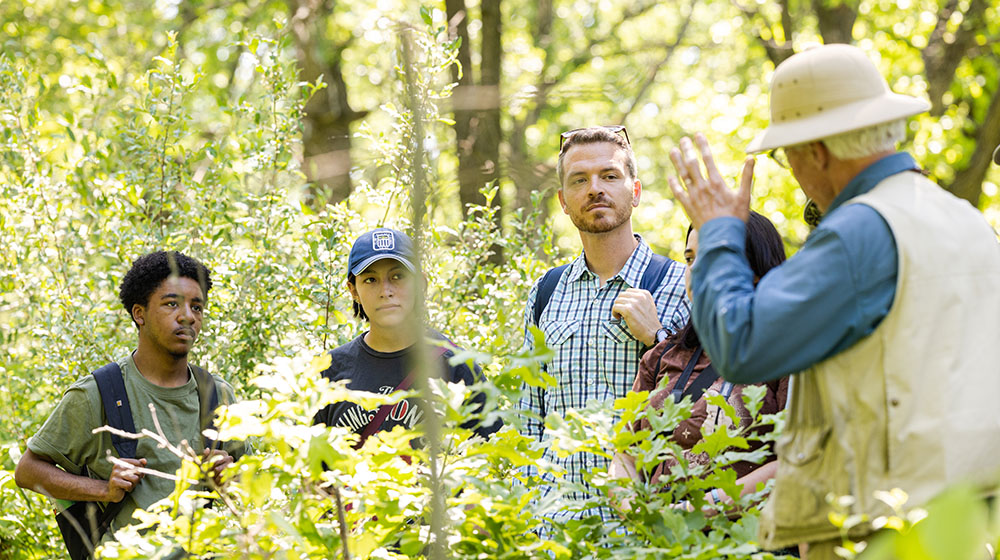
Field trips to local natural areas offered rich learning opportunities during the LUREC summer session.
In addition to time spent on the LUREC campus, field trips offered valuable learning experiences during the summer session. Students in the ecology class said their favorite experiences included kayaking in the Nippersink Creek and learning about ecological succession at Illinois Beach State Park. Highlights for herpetology students included a trip to Volo Bog State Natural Area, where they explored Illinois’ only remaining open-water quaking bog—a unique ecosystem featuring floating or partially floating peat.
Students said that while the LUREC courses were challenging, camaraderie with classmates and support from their professors made the experience fun and rewarding. Everyone who participated in the summer session said they would recommend the experience to others.
“I think it’s a good way to figure out what exactly you want to do,” said Jess Miller, a senior in environmental science who took the ecology class. “You get the research aspect of it. You get the going in the field and gathering data part of it. And it’s easier to connect the information you learn in class to what you’re doing outside.”
Madi Biesinger said she was nervous going into the experience but quickly became comfortable and had fun learning while exploring nature.
“It was a really impactful experience for me,” she said. “It was nice being around other students who were excited to be here. Even though it’s a lot of work packed into three weeks, everyone works together.”
Keylon Hampton agreed. “I’ve had a wonderful time,” he said. “I feel like every student should try to take at least one class at LUREC. It’s a very fun experience. And even though it’s a short amount of time when you learn a lot of things, it’s a good way to get out of the classroom, make new friends, connect with different SES folks and other environmental science individuals, and just learn more.”
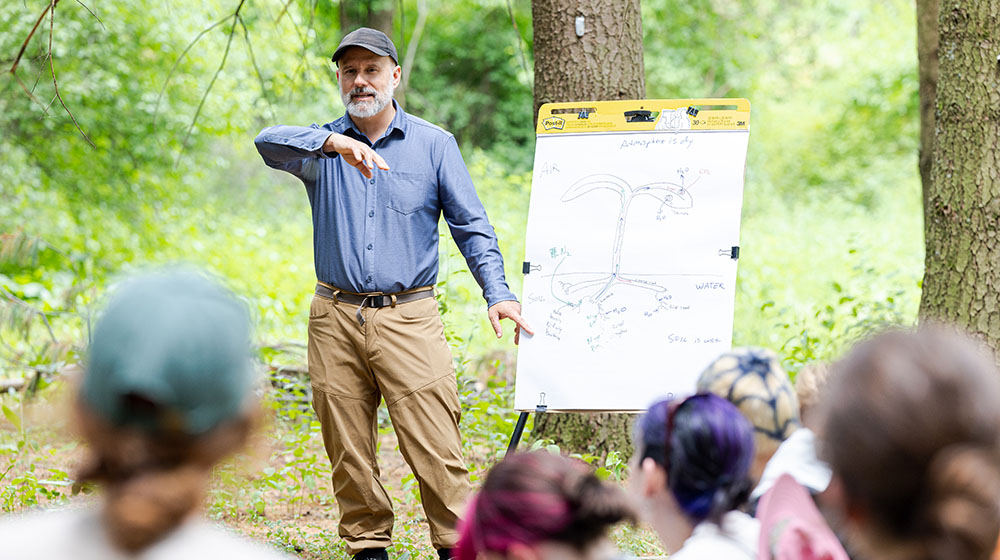
Ray Dybzinski, PhD, says the immersive LUREC courses create opportunities for students to see real-world examples of the ecological principles they study in class.
SES faculty members expect to offer principles of ecology and herpetology at LUREC again in future sessions. Other offerings could include field ornithology, agroecosystems, restoration ecology, environmental microbiology, and an introductory environmental science class for non-majors. The school will announce the summer 2024 course offerings in November 2023, and registration will open in February 2024.
In the meantime, those who are eager to visit LUREC can volunteer for monthly restoration workdays on the campus. Loyola’s Restoration Club organizes the workdays, which include activities such as removing invasive nonnative plants that disrupt local ecosystems. To learn more, email restorationclub@gmail.com.
LUREC is 50 miles northwest of the University’s Lake Shore Campus in McHenry County, Illinois. The campus includes hotel-style and dormitory accommodations, a dining hall, classrooms, lab facilities, and 100 acres of green space—making it an ideal location to study ecology and environmental sustainability.
SES offered two courses during this year’s LUREC summer session: principles of ecology (lecture and lab) and a new class on herpetology (the study of reptiles and amphibians). Students signed up for one of the two classes and lived on campus at LUREC during the session. Both courses included classroom instruction, lab activities, field trips, and hands-on outdoor experiences. Mark Mackey, SJ, MS, taught herpetology, and he had several goals for the course.
“I hoped students would be able to expand their ecological worldview to include the fascinating world (and requirements) of reptiles and amphibians,” he said. “By the end of the class, students learned the names, natural history, and identifying characteristics of the 100-plus species of reptiles and amphibians found in Illinois.”
Students interacted with 23 of reptiles and amphibians on the LUREC campus and in local natural areas. They learned to handle animals like green frogs, American toads, painted turtles, and milk snakes. Mackey said he was excited that they could catch and examine six milk snakes at LUREC.
“Milk snakes are rather secretive and can be quite hard to find, so to find this many individuals just a couple hundred yards from our indoor classroom was quite special,” he said.
Asha Egmont, a senior majoring in environmental studies and jazz studies, said she particularly enjoyed using technology to study turtles. She and her classmates used large hoop traps to catch turtles living in the pond at LUREC. They collected data such as species, size, and location before releasing the animals back into the pond. In some cases, the students outfitted turtles with a radio tracker that they later removed.
“We stick it on the back of their shell, and then they swim around. Then we walk around with an antenna and listen to some beeps, and when it gets louder, you know you’re getting closer. It’s like a big game of hot and cold,” Asha said.
The exercise helped students understand the turtles’ movements and gave them experience with wildlife radio telemetry—a tool scientists use to study animal behavior and population dynamics.
In addition to learning to identify local reptiles and amphibians, the herpetology students completed research projects and got practice with standard ecological research methods. They expanded their understanding of how herps interact with their environment and discovered how studying the animals can offer insights into broader ecological questions.
For many of Mackey’s students, being outside and interacting with the animals were highlights of the LUREC experience.
“Catching a snake is a cool feeling,” said Alex Risdal, a sophomore double majoring in environmental science and music. “I never thought I’d be able to reach into the bushes and grab a snake, and now I’m going around looking for them,” she said.
The outdoor activities were also a draw for students in the principles of ecology course, including Keylon Hampton, a senior majoring in environmental studies.
“I wanted to have an immersive experience outside. Having that immersive experience and being able to take what we learn in the classroom and being able to see it physically,” he said.
Associate Professor Ray Dybzinski, PhD, taught the principles of ecology course, which covered roughly a semester’s worth of material in a shortened time frame.
“I think the fact that it’s all so concentrated is a challenge, but it’s also an opportunity because we’re so immersed in this for three weeks,” said Dybzinski. “And I think the community building and the social aspects of this kind of learning are phenomenal.”
Dybzinski said teaching ecology at LUREC has some distinct advantages compared with a typical classroom setting. He noted that the 100-acre campus features habitats including grasslands, wetlands, oak savannas, agricultural fields, a pond, and a creek.
“There’s a lot of habitats crushed into one little space. For teaching ecology that’s very useful because in a short walk we can traverse very different habitats and look at how ecological principles play out differently in those different habitats,” he said.
During their time at LUREC, Dybzinski’s students took classroom learning into the field, and they brought samples collected outdoors into the lab for closer examination. Madi Biesinger is a senior in environmental science from San Antonio, Texas. She said she enjoyed collecting water from a pond on campus and looking at tiny aquatic organisms under a microscope.
“It was so cool to go out and gather my samples and then look at what I was able to gather and see things and identify them,” she said.
In another activity, microbiologist Greg Palmer, PhD, joined Dybzinski to lead an activity exploring the diversity of microscopic life found in soil. During the first week of the class, students collected soil samples at various locations on the LUREC campus. Under Palmer’s guidance, they mixed the soil with sterile water, created different dilutions, and put samples into Petri dishes containing agar. Palmer returned in the third week of class to help students examine the microbial colonies that grew in the Petri dishes. They found that the soil contained a tremendous quantity and variety of microbes.
“So that’s one thing I want the students to understand,” said Palmer. “There’s incredible diversity in every little gram of soil you walk on all the time. So when we think about the diversity of life on the planet, we need to not just think about tropical rain forests and coral reefs. The soil that we’re walking on every day has millions and millions of microbes.”
The microbes in soil play vital roles in decomposing organic matter and making nutrients available to plants. They also produce compounds that can be useful to people. Most of the antibiotics in use today come from bacteria found in soil.
In addition to time spent on the LUREC campus, field trips offered valuable learning experiences during the summer session. Students in the ecology class said their favorite experiences included kayaking in the Nippersink Creek and learning about ecological succession at Illinois Beach State Park. Highlights for herpetology students included a trip to Volo Bog State Natural Area, where they explored Illinois’ only remaining open-water quaking bog—a unique ecosystem featuring floating or partially floating peat.
Students said that while the LUREC courses were challenging, camaraderie with classmates and support from their professors made the experience fun and rewarding. Everyone who participated in the summer session said they would recommend the experience to others.
“I think it’s a good way to figure out what exactly you want to do,” said Jess Miller, a senior in environmental science who took the ecology class. “You get the research aspect of it. You get the going in the field and gathering data part of it. And it’s easier to connect the information you learn in class to what you’re doing outside.”
Madi Biesinger said she was nervous going into the experience but quickly became comfortable and had fun learning while exploring nature.
“It was a really impactful experience for me,” she said. “It was nice being around other students who were excited to be here. Even though it’s a lot of work packed into three weeks, everyone works together.”
Keylon Hampton agreed. “I’ve had a wonderful time,” he said. “I feel like every student should try to take at least one class at LUREC. It’s a very fun experience. And even though it’s a short amount of time when you learn a lot of things, it’s a good way to get out of the classroom, make new friends, connect with different SES folks and other environmental science individuals, and just learn more.”
SES faculty members expect to offer principles of ecology and herpetology at LUREC again in future sessions. Other offerings could include field ornithology, agroecosystems, restoration ecology, environmental microbiology, and an introductory environmental science class for non-majors. The school will announce the summer 2024 course offerings in November 2023, and registration will open in February 2024.
In the meantime, those who are eager to visit LUREC can volunteer for monthly restoration workdays on the campus. Loyola’s Restoration Club organizes the workdays, which include activities such as removing invasive nonnative plants that disrupt local ecosystems. To learn more, email restorationclub@gmail.com.
